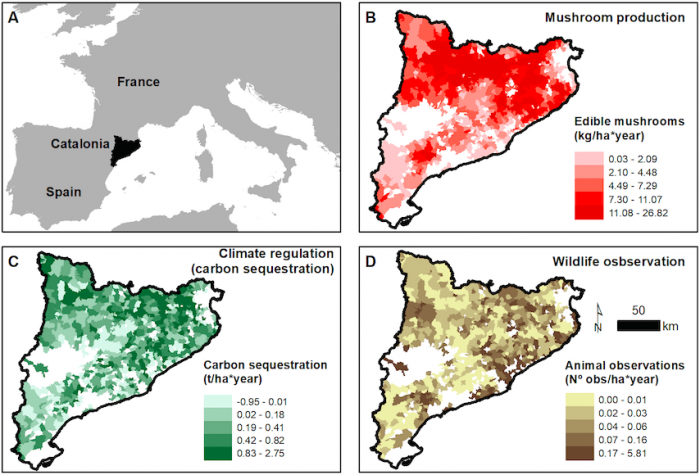
Why are forests relevant?
Forest ecosystems contain large amounts of different groups of organisms and play a key role in biodiversity conservation across the world’s biomes. In addition, their processes and overall ecological functioning provide a wide variety of goods and services to society (e.g. materials for construction or firewood for energy, carbon sequestration, or soil protection against erosion) that are key for human wellbeing.
However, different drivers related to global climate change, such as the abandonment of specific land use or extreme events associated with climate changes, are affecting these ecosystems and, in consequence, the goods and services they provide.
Why use the Mediterranean Basin and their forests as a study system?
The Mediterranean Basin is a highly biodiverse and highly populated region where anthropic impacts have modified their landscapes for millennia. These landscapes involve a mix of different forest and agricultural uses currently affected by different drivers of change, including frequent and intense wildfires and severe droughts.
An accurate knowledge of Mediterranean ecosystems and their ecological functioning, including the distribution patterns of forest ecosystem services, is key for their integration within strategies for land planning and management of natural resources. A group of researchers at CREAF (Centre for Ecological Research and Forestry Applications) has explored how information from multiple data sources can provide an accurate and spatially-explicit assessment of forest ecosystem services in Catalonia (north-eastern Spain).
Analyzing the relevance of the scale
We have studied the effects of the spatial scale for developing indicators of forest ecosystem services at the regional level in Catalonia by comparing information at the local scale (plots), the municipality, and the county level. The results obtained (published in Roces-Diaz et al. 2018a) showed that the use of municipalities measures provides similar patterns that more detailed scales (plots) and allows researchers to include a wider variety of information sources.
Mapping forest ecosystem services
We obtained maps of 12 different ecosystem services provided by forests in Catalonia (published in Roces-Diaz et al. 2018b) at the municipality level. For this, we compiled data from multiple sources (national forest inventories plots, simulations from different, previously-validated ecological models, land use/land cover maps, and administrative official and un-official –e.g., NGO’s- statistics). The services studied included the three main groups generally considered: i) provisioning (mushrooms, timber, and water); ii) regulating (climate regulation, soil fertility, water storage, flood protection, and erosion control); and iii) cultural (recreational, protected areas, wildlife observation, and recreational routes). Figure 1 shows the location of the study area and some of these services as examples.

Figure 1.Location of the study area (a) and some examples of forest ecosystem services mapped: mushrooms production (b), climate regulation (carbon sequestration; c) and wildlife observation (d). Image courtesy Jose V. Roces-Díaz
Our results showed that the montane forests in this area, located in its northern half, are particularly important for most services, such as those related with provisioning (mushrooms or water supply) and regulating (carbon sequestration or protection against soil erosion) aspects. However, ecosystems located in southern and eastern areas at lower altitudes and closer to large population centers (particularly the city of Barcelona) were highly relevant for cultural services (e.g., areas for observation of wildlife).
In general, we found that most of these services were strongly related with dominant climatic conditions of each municipality. Thus, those areas with higher precipitation showed higher levels of supply of food, materials, climate regulation, etc. In addition, biodiversity (e.g., tree species richness) showed a positive effect for most of the provisioning and regulating services, while socio-economic variables (such as population density) were more related with cultural services. We found few trade-offs between different ecosystem services in our spatial analysis.
Overall, our findings showed that the combination of multiple sources of information allowed developing detailed analyses of forest goods and services. In addition, the focus on municipalities as study units makes our results directly relevant for land management and planning strategies, including forest management, at local to regional levels.
These findings are described in the article entitled Assessing the distribution of forest ecosystem services in a highly populated Mediterranean region, recently published in the journal Ecological Indicators. This work was conducted by Jose V. Roces-Díaz from CREAF and Swansea University, Jordi Vayreda, Mireia Banqué-Casanovas, and Martí Cusó from CREAF, Marc Anton from the Natural History Museum of Barcelona, José A. Bonet from the Forest Sciences Centre of Catalonia and the Universitat de Lleida-Agrotecnio Center, Lluís Brotons from CREAF, the Forest Sciences Centre of Catalonia, and the Consejo Superior de Investigaciones Científicas (CSIC), Miquel De Cáceres from CREAF and the Forest Sciences Centre of Catalonia, Sergi Herrando from CREAF and the Natural History Museum of Barcelona, Juan Martínez de Aragón from the Forest Sciences Centre of Catalonia, Sergio de-Miguel from the Universitat de Lleida-Agrotecnio Center, and Jordi Martínez-Vilalta from CREAF and the Universitat Autònoma de Barcelona.
Acknowledgments and funding:
Funding was provided by the Catalan Office for Climate Change (OCCC) project ForESMap, from EU FORESTERRA program (INFORMED project) and from the Spanish government (CGL2013-46808-R, AGL2015-66001-C3-1-R and CGL2014-59742). Jose V Roces-Diaz was supported by the Government of Asturias and the FP7-Marie Curie-COFUND program of the European Commission (Grant ‘Clarín’ ACA17-02).
References:
- Roces-Díaz et al. The spatial level of analysis affects the patterns of forest ecosystem services supply and their relationships. Science of The Total Environment 626 (2018a): 1270-1283. https://doi.org/10.1016/j.scitotenv.2018.01.150
- Roces-Díaz et al. Assessing the distribution of forest ecosystem services in a highly populated Mediterranean region. Ecological Indicators 93 (2018b): 986-997. https://linkinghub.elsevier.com/retrieve/pii/S1470160X18304175









